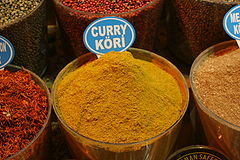- Curry powder
-
Curry powder is a mixture of spices of widely varying composition based on South Asian cuisine. Curry powder, and the contemporary English use of the word curry are Western inventions and do not reflect any specific Indian food, though a similar mixture of spices used in north India is called garam masala but curry powder is actually closer to the south Indian sambar powder. The word curry is widely believed to be a corruption of the Tamil word kari,[1] variously meaning something like sauce, cooked vegetables or meat.
In the western world, curry powder mixtures tend to have a fairly standardized taste, though a great variety of spice mixtures are used in Indian cuisine.
Curry powder was largely popularized during the nineteenth and twentieth centuries through the mass export of the condiment to the western table, throughout Europe and North and South America and through its use in British Army rations. Curry powder did not become standardized, as many of the original blends of curry powder were still available throughout the world. The late 1960s and early 1970s saw a growth of Indian-based food consumption in the west and internationally. This led to an increase of Indian restaurants throughout the world. The tradition of keeping special blends of curry powder simply became uneconomical, and curry powder became increasingly standardized outside India.
Indian cooks often have readier access to a variety of fresh spices than their foreign counterparts. Some curry cooks will have their own specific mixtures for different recipes. These are often passed down from parent to child.
Contents
Ingredients
Most recipes and producers of curry powder usually include coriander, turmeric, cumin, fenugreek, and red pepper in their blends. Depending on the recipe, additional ingredients such as ginger, garlic, asafoetida, fennel seed, caraway, cinnamon, clove, mustard seed, green cardamom, black cardamom, nutmeg, long pepper, and black pepper may also be added. However, the Portuguese importation of the chilli pepper from Brazil and their mixing of other Asian spices enabled the development of 'curi'. The Indian curry dish 'Vindaloo', from Goa, is a contraction of the Portuguese for 'Garlic Wine', or 'Vinho de alho'.[2]
It should be remembered that curry powder is more of a generic term for a blend of different spices. As with many things, curry powder can have more spices added to the mixture, whilst cooking, to suit the tastes of a particular individual.
See also
References
- ^ Harper, Douglas (November 2001). "Online Etymology Dictionary". http://www.etymonline.com/index.php?term=curry. Retrieved 8 November 2009., In Telugu Kari vepaaku (black neem)
- ^ Page, Martin (2007). The First Global Village: How Portugal Changed the World. Casa das Letras. p. 148. ISBN 9789724613130.
External links

This Pakistani cuisine-related article is a stub. You can help Wikipedia by expanding it.

